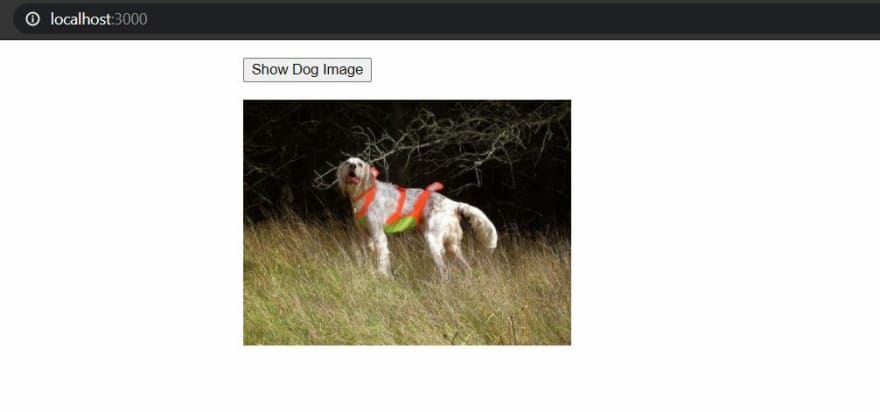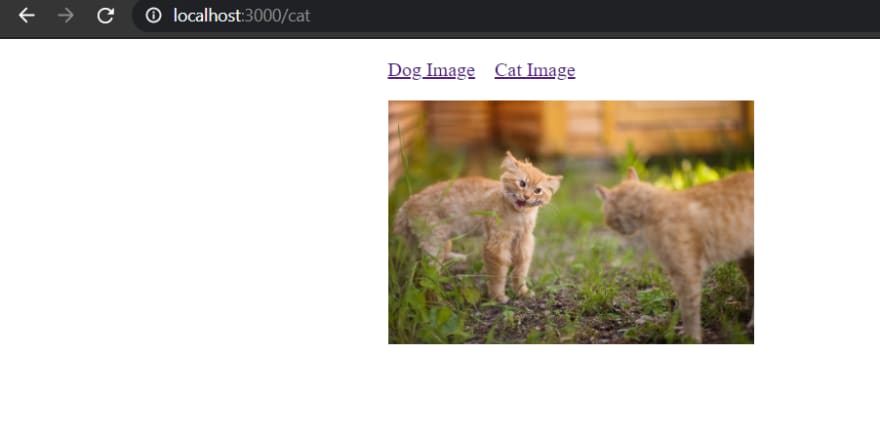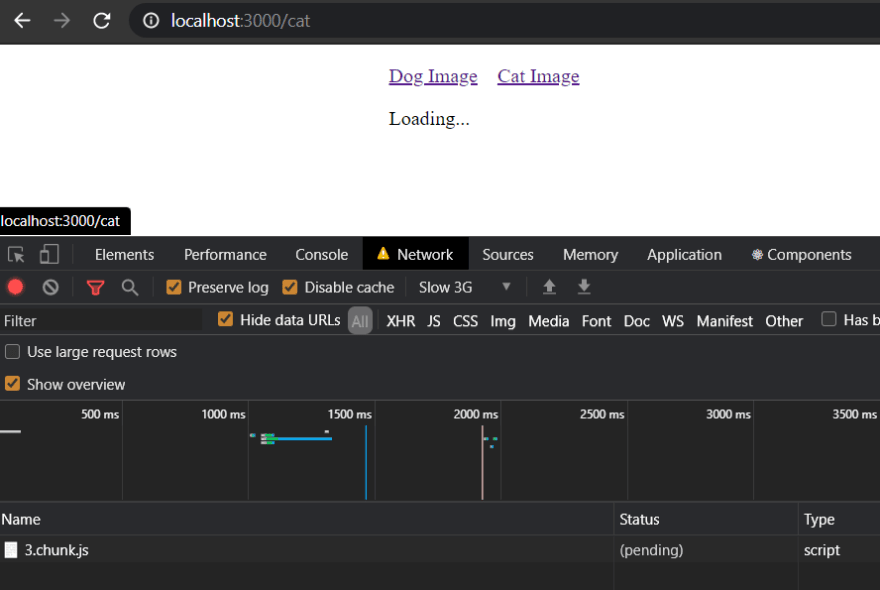An Interest In:
Web News this Week
- April 1, 2024
- March 31, 2024
- March 30, 2024
- March 29, 2024
- March 28, 2024
- March 27, 2024
- March 26, 2024
Code Splitting in React using React.lazy and Loadable Components
When our project grows and we add more functionalities, we end up adding a lot of code and libraries,
which result in a larger bundle size. A bundle size of a few hundred KBs might not feel a lot,
but in slower networks or in mobile networks it will take a longer time to load thus creating a bad user experience.
The solution to this problem is to reduce the bundle size.
But if we delete the large packages then our functionalities will be broken. So we will not be deleting the packages,
but we will only be loading the js code which is required for a particular page.
Whenever the user navigates or performs an action on the page, we will download the code on the fly,
thereby speeding up the initial page load.
When the Create React App builds the code for production, it generates only 2 main files:
- A file having react library code and its dependencies.
- A file having your app logic and its dependencies.
So to generate a separate file for each component or each route we can either make use of React.lazy,
which comes out of the box with react or any other third party library. In this tutorial, we will see both the ways.
Initial Project Setup
Create a react app using the following command:
npx create-react-app code-splitting-reactCode splitting using React.lazy
Create a new component Home inside the file Home.js with the following code:
import React, { useState } from "react"const Home = () => { const [showDetails, setShowDetails] = useState(false) return ( <div> <button onClick={() => setShowDetails(true)} style={{ marginBottom: "1rem" }} > Show Dog Image </button> </div> )}export default HomeHere we have a button, which on clicked will set the value of showDetails state to true.
Now create DogImage component with the following code:
import React, { useEffect, useState } from "react"const DogImage = () => { const [imageUrl, setImageUrl] = useState() useEffect(() => { fetch("https://dog.ceo/api/breeds/image/random") .then(response => { return response.json() }) .then(data => { setImageUrl(data.message) }) }, []) return ( <div> {imageUrl && ( <img src={imageUrl} alt="Random Dog" style={{ width: "300px" }} /> )} </div> )}export default DogImageIn this component,
whenever the component gets mounted we are fetching random dog image from Dog API using the useEffect hook.
When the URL of the image is available, we are displaying it.
Now let's include the DogImage component in our Home component, whenever showDetails is set to true:
import React, { useState } from "react"import DogImage from "./DogImage"const Home = () => { const [showDetails, setShowDetails] = useState(false) return ( <div> <button onClick={() => setShowDetails(true)} style={{ marginBottom: "1rem" }} > Show Dog Image </button> {showDetails && <DogImage />} </div> )}export default HomeNow include Home component inside App component:
import React from "react"import Home from "./Home"function App() { return ( <div className="App"> <Home /> </div> )}export default AppBefore we run the app, let's add few css to index.css:
body { margin: 1rem auto; max-width: 900px;}Now if you run the app and click on the button, you will see a random dog image:
Wrapping with Suspense
React introduced Suspense in version 16.6,
which lets you wait for something to happen before rendering a component.
Suspense can be used along with React.lazy for dynamically loading a component.
Since details of things being loaded or when the loading will complete is not known until it is loaded, it is called suspense.
Now we can load the DogImage component dynamically when the user clicks on the button.
Before that, let's create a Loading component that will be displayed when the component is being loaded.
import React from "react"const Loading = () => { return <div>Loading...</div>}export default LoadingNow in Home.js let's dynamically import DogImage component using React.lazy and wrap the imported component with Suspense:
import React, { Suspense, useState } from "react"import Loading from "./Loading"// Dynamically Import DogImage componentconst DogImage = React.lazy(() => import("./DogImage"))const Home = () => { const [showDetails, setShowDetails] = useState(false) return ( <div> <button onClick={() => setShowDetails(true)} style={{ marginBottom: "1rem" }} > Show Dog Image </button> {showDetails && ( <Suspense fallback={<Loading />}> <DogImage /> </Suspense> )} </div> )}export default HomeSuspense accepts an optional parameter called fallback,
which will is used to render a intermediate screen when the components wrapped inside Suspense is being loaded.
We can use a loading indicator like spinner as a fallback component.
Here, we are using Loading component created earlier for the sake of simplicity.
Now if you simulate a slow 3G network and click on the "Show Dog Image" button,
you will see a separate js code being downloaded and "Loading..." text being displayed during that time.
Analyzing the bundles
To further confirm that the code split is successful, let's see the bundles created using webpack-bundle-analyzer
Install webpack-bundle-analyzer as a development dependency:
yarn add webpack-bundle-analyzer -DCreate a file named analyze.js in the root directory with the following content:
// script to enable webpack-bundle-analyzerprocess.env.NODE_ENV = "production"const webpack = require("webpack")const BundleAnalyzerPlugin = require("webpack-bundle-analyzer") .BundleAnalyzerPluginconst webpackConfigProd = require("react-scripts/config/webpack.config")( "production")webpackConfigProd.plugins.push(new BundleAnalyzerPlugin())// actually running compilation and waiting for plugin to start explorerwebpack(webpackConfigProd, (err, stats) => { if (err || stats.hasErrors()) { console.error(err) }})Run the following command in the terminal:
node analyze.jsNow a browser window will automatically open with the URL http://127.0.0.1:8888
If you see the bundles, you will see that DogImage.js is stored in a different bundle than that of Home.js:
Error Boundaries
Now if you try to click on "Show Dog Image" when you are offline,
you will see a blank screen and if your user encounters this, they will not know what to do.
This will happen whenever there no network or the code failed to load due to any other reason.
If we check the console for errors, we will see that React telling us to add
error boundaries:
We can make use of error boundaries to handle any unexpected error that might occur during the run time of the application.
So let's add an error boundary to our application:
import React from "react"class ErrorBoundary extends React.Component { constructor(props) { super(props) this.state = { hasError: false } } static getDerivedStateFromError(error) { return { hasError: true } } render() { if (this.state.hasError) { return <p>Loading failed! Please reload.</p> } return this.props.children }}export default ErrorBoundaryIn the above class based component,
we are displaying a message to the user to reload the page whenever the local state hasError is set to true.
Whenever an error occurs inside the components wrapped within ErrorBoundary,getDerivedStateFromError will be called and hasError will be set to true.
Now let's wrap our suspense component with error boundary:
import React, { Suspense, useState } from "react"import ErrorBoundary from "./ErrorBoundary"import Loading from "./Loading"// Dynamically Import DogImage componentconst DogImage = React.lazy(() => import("./DogImage"))const Home = () => { const [showDetails, setShowDetails] = useState(false) return ( <div> <button onClick={() => setShowDetails(true)} style={{ marginBottom: "1rem" }} > Show Dog Image </button> {showDetails && ( <ErrorBoundary> <Suspense fallback={<Loading />}> <DogImage /> </Suspense> </ErrorBoundary> )} </div> )}export default HomeNow if our users click on "Load Dog Image" when they are offline, they will see an informative message:
Code Splitting Using Loadable Components
When you have multiple pages in your application and if you want to bundle code of each route a separate bundle.
We will make use of react router dom for routing in this app.
In my previous article, I have explained in detail about React Router.
Let's install react-router-dom and history:
yarn add react-router-dom@next historyOnce installed, let's wrap App component with BrowserRouter inside index.js:
import React from "react"import ReactDOM from "react-dom"import "./index.css"import App from "./App"import { BrowserRouter } from "react-router-dom"ReactDOM.render( <React.StrictMode> <BrowserRouter> <App /> </BrowserRouter> </React.StrictMode>, document.getElementById("root"))Let's add some Routes and Navigation links in App.js:
import React from "react"import { Link, Route, Routes } from "react-router-dom"import CatImage from "./CatImage"import Home from "./Home"function App() { return ( <div className="App"> <ul> <li> <Link to="/">Dog Image</Link> </li> <li> <Link to="cat">Cat Image</Link> </li> </ul> <Routes> <Route path="/" element={<Home />}></Route> <Route path="cat" element={<CatImage />}></Route> </Routes> </div> )}export default AppNow let's create CatImage component similar to DogImage component:
import React, { useEffect, useState } from "react"const DogImage = () => { const [imageUrl, setImageUrl] = useState() useEffect(() => { fetch("https://aws.random.cat/meow") .then(response => { return response.json() }) .then(data => { setImageUrl(data.file) }) }, []) return ( <div> {imageUrl && ( <img src={imageUrl} alt="Random Cat" style={{ width: "300px" }} /> )} </div> )}export default DogImageLet's add some css for the navigation links in index.css:
body { margin: 1rem auto; max-width: 900px;}ul { list-style-type: none; display: flex; padding-left: 0;}li { padding-right: 1rem;}Now if you open the /cat route, you will see a beautiful cat image loaded:
In order to load the CatImage component to a separate bundle, we can make use of loadable components.
Let's add @loadable-component to our package:
yarn add @loadable/componentIn App.js, let's load the CatImage component dynamically using loadable function,
which is a default export of the loadable components we installed just now:
import React from "react"import { Link, Route, Routes } from "react-router-dom"import Home from "./Home"import loadable from "@loadable/component"import Loading from "./Loading"const CatImage = loadable(() => import("./CatImage.js"), { fallback: <Loading />,})function App() { return ( <div className="App"> <ul> <li> <Link to="/">Dog Image</Link> </li> <li> <Link to="cat">Cat Image</Link> </li> </ul> <Routes> <Route path="/" element={<Home />}></Route> <Route path="cat" element={<CatImage />}></Route> </Routes> </div> )}export default AppYou can see that even loadable function accepts a fallback component to display a loader/spinner.
Now if you run the application in a slow 3G network,
you will see the loader and js bundle related to CatImage component being loaded:
Now if you run the bundle analyzer using the following command:
node analyze.jsYou will see that CatImage is located inside a separate bundle:
You can use
React.lazyfor Route based code splitting as well.
Source code and Demo
You can view the complete source code here and a demo here.
Original Link: https://dev.to/collegewap/code-splitting-in-react-using-react-lazy-and-loadable-components-3o54
Dev To
 An online community for sharing and discovering great ideas, having debates, and making friends
An online community for sharing and discovering great ideas, having debates, and making friendsMore About this Source Visit Dev To










